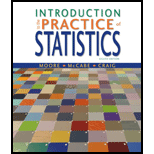
Concept explainers
To find: The probabilities for the provided five intervals.
Answer to Problem 50E
Solution: The probabilities for the provided intervals are given in the following table:
| Interval | Probability |
| 0.2743 | |
| 0.1859 | |
| 0.0796 | |
| 0.1859 | |
| 0.2743 |
Explanation of Solution
Calculation: From Table A, in the left side z-score table, look for
From Table A, the probability less than
The expected number of frequency can be calculated as
To obtain the probability less than 0.1, use Table A, look for 0.1 in the row and 0.00 in the column and the intercept term is found to be 0.5398. Similarly, the probability for less than
The expected number of frequency is calculated as
To obtain the probability less than 0.6, use Table A. Look for 0.6 in the row and 0.00 in the column and the intercept term is found to be 0.7257. Similarly, the probability for less than 0.1 is 0.5398. The required probability further can be calculated as given below:
The expected number of frequency is calculated as
To obtain the probability less than 0.6, use Table A. Look for 0.6 in the row and 0.00 in the column and the intercept term is found to be 0.7257. The required probability further can be calculated as given below:
The expected number of frequency is calculated as
The table that shows the expected counts is given below:
| Expected counts | Observed Counts |
| 137.15 | 139 |
| 92.95 | 102 |
| 39.80 | 41 |
| 92.95 | 78 |
| 137.15 | 140 |
Defining the null and alternative hypothesis for goodness of fit testing:
Further, chi-square testing goodness of fit has been done using Minitab software by following steps:
Step 1: Input the data in the Minitab worksheet.
Step 2: Go to Stat and select “Chi-Square Goodness-of-Fit (One- variable)” under the option tables.
Step 3: Enter the frequency as “Observed Count.”
Step 4: Specify “proportions specified by historical counts” by choosing the “Input column” from the pop-up menu.
After implementing these 4 steps, a table will appear in the output box where chi-square value of the desired result is given, that is, 3.41 and the P-value is 0.492.
Interpretation: The
Want to see more full solutions like this?
Chapter 9 Solutions
Introduction to the Practice of Statistics: w/CrunchIt/EESEE Access Card
 MATLAB: An Introduction with ApplicationsStatisticsISBN:9781119256830Author:Amos GilatPublisher:John Wiley & Sons Inc
MATLAB: An Introduction with ApplicationsStatisticsISBN:9781119256830Author:Amos GilatPublisher:John Wiley & Sons Inc Probability and Statistics for Engineering and th...StatisticsISBN:9781305251809Author:Jay L. DevorePublisher:Cengage Learning
Probability and Statistics for Engineering and th...StatisticsISBN:9781305251809Author:Jay L. DevorePublisher:Cengage Learning Statistics for The Behavioral Sciences (MindTap C...StatisticsISBN:9781305504912Author:Frederick J Gravetter, Larry B. WallnauPublisher:Cengage Learning
Statistics for The Behavioral Sciences (MindTap C...StatisticsISBN:9781305504912Author:Frederick J Gravetter, Larry B. WallnauPublisher:Cengage Learning Elementary Statistics: Picturing the World (7th E...StatisticsISBN:9780134683416Author:Ron Larson, Betsy FarberPublisher:PEARSON
Elementary Statistics: Picturing the World (7th E...StatisticsISBN:9780134683416Author:Ron Larson, Betsy FarberPublisher:PEARSON The Basic Practice of StatisticsStatisticsISBN:9781319042578Author:David S. Moore, William I. Notz, Michael A. FlignerPublisher:W. H. Freeman
The Basic Practice of StatisticsStatisticsISBN:9781319042578Author:David S. Moore, William I. Notz, Michael A. FlignerPublisher:W. H. Freeman Introduction to the Practice of StatisticsStatisticsISBN:9781319013387Author:David S. Moore, George P. McCabe, Bruce A. CraigPublisher:W. H. Freeman
Introduction to the Practice of StatisticsStatisticsISBN:9781319013387Author:David S. Moore, George P. McCabe, Bruce A. CraigPublisher:W. H. Freeman





